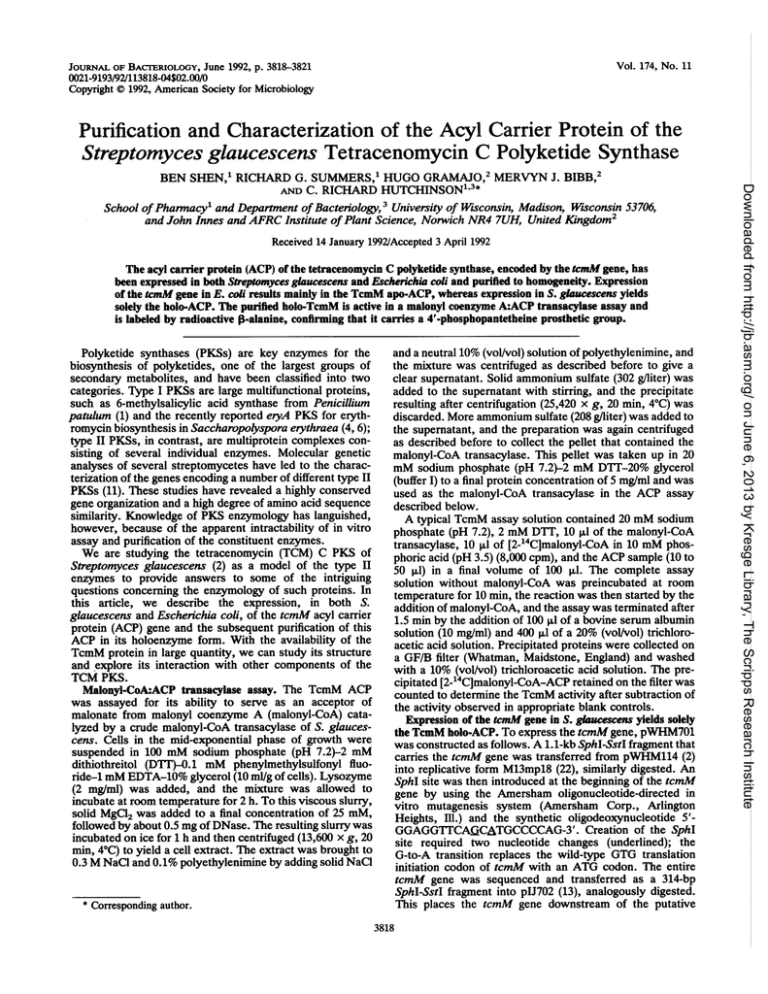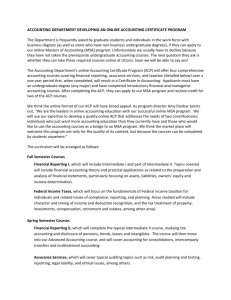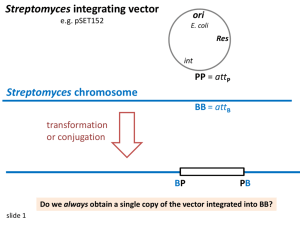Purification and Characterization Streptomyces glaucescens Tetracenomycin
advertisement

Vol. 174, No. 11 JOURNAL OF BACTERIOLOGY, June 1992, p. 3818-3821 0021-9193/92/113818-04$02.00/0 Copyright C) 1992, American Society for Microbiology Purification and Characterization of the Acyl Carrier Protein of the Streptomyces glaucescens Tetracenomycin C Polyketide Synthase Received 14 January 1992/Accepted 3 April 1992 The acyl carrier protein (ACP) of the tetracenomycin C polyketide synthase, encoded by the tcmM gene, has been expressed in both Streptomyces glaucescens and Escherichia coli and purified to homogeneity. Expression of the tcmM gene in E. coli results mainly in the TcmM apo-ACP, whereas expression in S. glaucescens yields solely the holo-ACP. The purified holo-TcmM is active in a malonyl coenzyme A:ACP transacylase assay and is labeled by radioactive 13-alanine, confirming that it carries a 4'-phosphopantetheine prosthetic group. Polyketide synthases (PKSs) are key enzymes for the biosynthesis of polyketides, one of the largest groups of secondary metabolites, and have been classified into two categories. Type I PKSs are large multifunctional proteins, such as 6-methylsalicylic acid synthase from Penicillium patulum (1) and the recently reported eryA PKS for erythromycin biosynthesis in Saccharopolyspora erythraea (4, 6); type II PKSs, in contrast, are multiprotein complexes consisting of several individual enzymes. Molecular genetic analyses of several streptomycetes have led to the characterization of the genes encoding a number of different type II PKSs (11). These studies have revealed a highly conserved gene organization and a high degree of amino acid sequence similarity. Knowledge of PKS enzymology has languished, however, because of the apparent intractability of in vitro assay and purification of the constituent enzymes. We are studying the tetracenomycin (TCM) C PKS of Streptomyces glaucescens (2) as a model of the type II enzymes to provide answers to some of the intriguing questions concerning the enzymology of such proteins. In this article, we describe the expression, in both S. glaucescens and Escherichia coli, of the tcmM acyl carrier protein (ACP) gene and the subsequent purification of this ACP in its holoenzyme form. With the availability of the TcmM protein in large quantity, we can study its structure and explore its interaction with other components of the TCM PKS. Malonyl-CoAACP transacylase assay. The TcmM ACP was assayed for its ability to serve as an acceptor of malonate from malonyl coenzyme A (malonyl-CoA) catalyzed by a crude malonyl-CoA transacylase of S. glaucescens. Cells in the mid-exponential phase of growth were suspended in 100 mM sodium phosphate (pH 7.2)-2 mM dithiothreitol (DTT)-0.1 mM phenylmethylsulfonyl fluoride-i mM EDTA-10% glycerol (10 ml/g of cells). Lysozyme (2 mg/ml) was added, and the mixture was allowed to incubate at room temperature for 2 h. To this viscous slurry, solid MgCl2 was added to a final concentration of 25 mM, followed by about 0.5 mg of DNase. The resulting slurry was incubated on ice for 1 h and then centrifuged (13,600 x g, 20 min, 4°C) to yield a cell extract. The extract was brought to 0.3 M NaCl and 0.1% polyethylenimine by adding solid NaCl * Corresponding author. and a neutral 10% (vol/vol) solution of polyethylenimine, and the mixture was centrifuged as described before to give a clear supernatant. Solid ammonium sulfate (302 g/liter) was added to the supernatant with stirring, and the precipitate resulting after centrifugation (25,420 x g, 20 min, 4°C) was discarded. More ammonium sulfate (208 g/liter) was added to the supernatant, and the preparation was again centrifuged as described before to collect the pellet that contained the malonyl-CoA transacylase. This pellet was taken up in 20 mM sodium phosphate (pH 7.2)-2 mM DTT-20% glycerol (buffer I) to a final protein concentration of 5 mg/ml and was used as the malonyl-CoA transacylase in the ACP assay described below. A typical TcmM assay solution contained 20 mM sodium phosphate (pH 7.2), 2 mM DTT, 10 ,ul of the malonyl-CoA transacylase, 10 ,ul of [2-'4CJmalonyl-CoA in 10 mM phosphoric acid (pH 3.5) (8,000 cpm), and the ACP sample (10 to 50 pl) in a final volume of 100 ,ul. The complete assay solution without malonyl-CoA was preincubated at room temperature for 10 min, the reaction was then started by the addition of malonyl-CoA, and the assay was terminated after 1.5 min by the addition of 100 ,ul of a bovine serum albumin solution (10 mg/ml) and 400 pl of a 20% (vol/vol) trichloroacetic acid solution. Precipitated proteins were collected on a GF/B filter (Whatman, Maidstone, England) and washed with a 10% (vol/vol) trichloroacetic acid solution. The precipitated [2-14CJmalonyl-CoA-ACP retained on the filter was counted to determine the TcmM activity after subtraction of the activity observed in appropriate blank controls. Expression of the tcmM gene in S. glaucescens yields solely the TcmM holo-ACP. To express the tcmM gene, pWHM701 was constructed as follows. A 1.1-kb SphI-SstI fragment that carries the tcmM gene was transferred from pWHM114 (2) into replicative form M13mpl8 (22), similarly digested. An SphI site was then introduced at the beginning of the tcmM gene by using the Amersham oligonucleotide-directed in vitro mutagenesis system (Amersham Corp., Arlington Heights, Ill.) and the synthetic oligodeoxynucleotide 5'GGAGG1TCAkCATGCCCCAG-3'. Creation of the SphI site required two nucleotide changes (underlined); the G-to-A transition replaces the wild-type GTG translation initiation codon of tcmM with an ATG codon. The entire tcmM gene was sequenced and transferred as a 314-bp SphI-SstI fragment into pIJ702 (13), analogously digested. This places the tcmM gene downstream of the putative 3818 Downloaded from http://jb.asm.org/ on June 6, 2013 by Kresge Library, The Scripps Research Institute BEN SHEN,' RICHARD G. SUMMERS,' HUGO GRAMAJO,2 MERVYN J. BIBB,2 AND C. RICHARD HUTCHINSON .3* School of Phannacy' and Department of Bacteriology,3 University of Wisconsin, Madison, Wisconsin 53706, and John Innes and AFRC Institute of Plant Science, Norwich NR4 7UH, United Kingdom2 VOL. 174, 1992 NOTES 3819 TABLE 1. A summary of the steps for the purification of the TcmM ACP produced in S. glaucescens and E. coli Protein (mg) in: Stepsa S. glaucescens cellsb 4,500 4,100 982 81.5 Superose 6 28.5 0.855 754.4 731.4 112.0 22.2 1.26 0.775 Stationary-phase E. coli cells' 517.7 485.8 210.0 17.7 1.12 0.828 (apoenyzme form) 0.053 (holoenzyme form) 0.44 a As described in the text. b From 70 g of cells. c From 5.5 g of cells. dFrom 3.3 g of cells. e PEI, polyethylenimine. ribosome binding site of the mel operon copper transport protein under the control of the melCl promoter in pIJ702. S. glaucescens WMH1077 (formerly GLA.5-1) transformed with pWHM701 was grown in R2YENG medium (15) containing thiostrepton (20 ,ug/ml) at 30°C and 300 rpm for 28 h. Cells (25 g/liter) were harvested and washed, a cell extract was prepared as described earlier, and polyethylenimine (0.1%) and ammonium sulfate (302 g/liter) precipitation followed. After discarding this precipitate, more ammonium sulfate (208 g/liter) was added to the supernatant and the precipitate was collected by centrifugation (25,420 x g, 20 min, 4°C). The remaining supernatant was adjusted to pH 3.9 with glacial acetic acid and stirred overnight at 4°C; centrifugation followed as described before. The combined ammonium sulfate and acid pellets were dialyzed against 25 mM Tris-HCl (pH 8.0)-i mM DTT (buffer II) and applied to a Q Sepharose fast-flow (Pharmacia, Piscataway, N.J.) column (2.6 by 18 cm) at room temperature. The column was washed with buffer II and developed with a linear 240-ml gradient from 0 to 0.5 M NaCl in buffer II at a flow rate of 6 ml/min. Fractions from this and succeeding purification steps were assayed by sodium dodecyl sulfate-polyacrylamide gel electrophoresis (SDS-PAGE) performed on a PhastSystem (Pharmacia) and by the malonyl-CoA-ACP transacylase assay to determine the presence of TcmM. The fractions were then pooled and dialyzed against 25 mM Tris-HCl (pH 8.0)-i mM DTT-0.2 M NaCl (buffer III) and applied to a Mono Q HR 10/10 column (Pharmacia) at room temperature. The column was washed with buffer III and developed with a linear 120-ml gradient from 0.2 to 0.5 M NaCl in buffer III at a flow rate of 4 ml/min. The pooled fractions containing the ACP were brought to 1.8 M ammonium sulfate by adding solid ammonium sulfate and applied to a Phenyl Superose HR 5/5 column (Pharmacia) at room temperature. The column was washed with 50 mM sodium phosphate (pH 7.2)-i mM DTT (buffer IV) containing 1.8 M ammonium sulfate and then developed with a linear 15-ml gradient from 1.8 to 0 M ammonium sulfate in buffer IV at a flow rate of 0.5 ml/min. The pooled fractions containing the ACP from the Phenyl Superose column were concentrated in Centricon 10 filtration units (Amicon, Danvers, Mass.) and applied to a Superose 6 HR 10/30 column (Pharmacia) at room temperature. The protein was eluted with 20 mM sodium phosphate (pH 7.2)-2 mM D1T-150 mM NaCl (buffer V) at a flow rate of 0.5 ml/min. The final fractions exhibited a single band by SDS-PAGE. The results of purification of the TcmM ACP produced in S. glaucescens are summarized in Table 1. Like various fatty acid synthase (FAS) ACPs (17, 18), the TCM PKS ACP behaves abnormally on a gel filtration column with an apparent Mr of 21,000 and in SDS-PAGE with an apparent Mr of 5,500 (8). (The expected Mr is 9,292 [2].) Purified TcmM is active in the malonyl-CoA-ACP transacylase assay, suggesting that the apo-ACP has been posttranslationally modified by the attachment of the 4'-phosphopantetheine prosthetic group. This was confirmed by in vivo labeling with [3-3H]P-alanine, which specifically labels the 4'-phosphopantetheine group (9, 12, 21): [3H]TcmM was recovered from S. glaucescens WMH1077(pWHM701) that had been grown in 500 ml of R2YENG medium containing thiostrepton (20 ,ug/ml) and [3-3H],-alanine (10 ,uCi). Expression of the tcmM gene in E. coli mainly results in the TcmM apo-ACP. E. coli K38 transformed with plasmids pGP1-2 and pIJ2238 (8) was used as described by Gramajo et al. (8). Cells were grown at 30°C in 2x YT medium (8) containing kanamycin and ampicillin (50 ,ug/ml each). When the culture reached an A600 of 1.5 to 2.0 (exponential phase of growth), the temperature was shifted to 42°C and growth was continued for 2 h. Cells (5.5 g/liter) were then harvested and washed sequentially with 0.5 M NaCl and 0.1 M sodium phosphate (pH 7.2). TcmM was purified to homogeneity by the procedure described above with the following exceptions. The combined ammonium sulfate and glacial acetic acid pellets were dissolved in a minimum volume of buffer I and applied to a Sephacryl S-200 HR (Pharmacia) column (2.6 by 60 cm). Fractions were collected by elution with buffer V at room temperature at a flow rate of 2.0 ml/min. After gel filtration, the ACP was further purified on Mono Q HR 10/10 and Phenyl Superose HR 5/5 columns as described earlier (Table 1). After desalting by passage through a Vydac (Hesperia, Calif.) protein C4 reverse-phase high-pressure liquid chromatography column developed with a linear 50-ml gradient from 5 to 95% acetonitrile in 0.1% trifluoroacetic acid at a flow rate of 1.0 ml/min, the amino-terminal sequence of the purified TcmM was determined by the automated Edman degradation method. The first 10 amino acid residues (the V shown in Fig. 2 was not present) were identical to those predicted from the sequence of the tcmM gene (2). Interestingly, the TcmM ACP purified from E. coli was inactive in the malonyl-CoA-ACP transacylase assay. To determine if this ACP was modified by attachment of the Downloaded from http://jb.asm.org/ on June 6, 2013 by Kresge Library, The Scripps Research Institute Crude cell extract PEI' precipitation (supernatant) (NH4)2SO4 and glacial acetic acid precipitation (pellet) Q Sepharose Sephacryl S-200 Mono Q Phenyl Superose Exponential-phase E. coli cellsC NOTES 3820 1 2 J. BAcTERIOL. 3 4 5 6 7 8 9 10 4'-phosphopantetheine prosthetic group, a sample of the purified ACP was analyzed by electrospray mass spectrometry (3, 17). The major peak had a molecular weight of 8,963.33 ± 6.76, which is in reasonable agreement with the molecular weight of the apoenzyme (8,951.88) predicted from the sequence of the tcnmM gene. The same sample was also analyzed by 31P nuclear magnetic resonance (19), and no 31P resonance was observed, confirming the absence of the 4'-phosphopantetheine group. Finally, when E. coli K38(pGP1-2/pIJ2238) was grown in 500 ml of 2x YT medium containing kanamycin and ampicillin (50 ,ug/ml each) and ,3-3H]II-alanine (10 ,uCi), the purified TcmM ACP was not H labeled in vivo, although the E. coli FAS ACP was labeled in this experiment (data not shown). In most cases, ACP genes from diverse species are expressed in E. coli exclusively (7, 9) or predominantly in their holoenzyme form (17). Since this was not our experience, the conditions for producing the TcmM holo-ACP in E. coli were explored. We observed that the ratio of apo- to holo-ACP varied as a function of the growth conditions of E. coli K38(pGP1-2/pIJ2238). To increase the amount of the holo-ACP, E. coli K38(pGP1-2/pU2238) was grown at 30°C in 2x YT medium containing kanamycin and ampicillin (50 kg/ml each) to anA6. of approximately 10 (stationary phase of growth). The temperature was raised to 42°C for 30 min and then lowered to 30°C for an additional 2 h. The cells (4.4 g/liter) were harvested and washed, and TcmM was purified as described earlier, during which we found that the TcmM apo- and holo-ACPs could be resolved on Mono Q or Phenyl Superose columns. As summarized in Table 1, 5 to 10% of the total TcmM isolated from the stationary-phase cells was 99 50 1 matlLTtDDL rralVEcAGE tDGtDLsGdf LDlrF.EDiG YDSLALmEta arLEsrYGVS IPDDvagrVd TpRelLDLIN Ga1AEAA* .. ......... S. coelicolor ACP S. violaceoruber ACP .marLTLDgL rtilVacAGE dDGVDLaGdi LDitF.EELG YDSLALmEsa sriErELGVa laDgDinEel TpRvlLDLVN GaQAEAA* .. ......... TcmM ACP .vpqigLprL vEiirEcAGD pDerDLDGdi LDvtY.qDLG YDSiALlEis akLEqDLGVS IPgE ...Elk TpRhtLhLVN tetAgeva*. PKS E. coli ACP Sac. erythraea ACP S. glaucescens ACP Consensus sti eErvkkiiGE QlGVkqEevt dnasFvEDLG aDSLdtvElV drkEiF eErieqvlaE QiGIpaEqit eEadLrEDLG mDSLdLvElV ..maaTqEEi vaglaDivnE iaGIpvEdvq LDksFtDDLd vDSLsMvEvV ----LTL--L -E--VE-AGE QODG-DLEG-- LD--F-EDLG YDSLAL-E-V ....... .... mALEEEFdte IPDEEaEkIt TvqaaiDyIN sALEDEvGmr VeqsqlEgIe TvghvMELtl vAaEErFdVk IPDEDvknlk TvgdatEyIl -ALEEE-GVS IPDED-EEI- T-R--LDLIN GhQA* ..... dIvArlAtas aadkpeaas* khQA*. G-QAEAA--- ......... FIG. 2. Alignment of the deduced amino acid sequence of the TCM PKS ACP (2) with E. coli FAS ACP (11), S. erythraea FAS ACP (17), S. glaucescens FAS ACP (5), Streptomyces coelicolor PKS ACP (11), and Streptomyces violaceonber PKS ACP (20). The serine of the prosthetic group attachment site is shown in boldface type. Capital letters indicate identity of two or more amino acids in a vertical column. Stars indicate translation stops. Downloaded from http://jb.asm.org/ on June 6, 2013 by Kresge Library, The Scripps Research Institute FIG. 1. Immunoblot of the conformationally sensitive PAGE of the TcmM ACP produced in E. coli and S. glaucescens. Lanes: 1, E. coli K38(pGP1-2/pIJ2238) culture induced in the exponential phase; 2, E. coli K38(pGP1-2/pIJ2238) culture induced in the stationary phase; 3, mixture of the TcmM apo- and holo-ACPs; 4, TcmM apo-ACP; 5, TcmM holo-ACP; 6, 12-h-old S. glaucescens culture; 7, 18-h-old S. glaucescens culture; 8, 28-h-old S. glaucescens culture; 9, 28-h-old S. glaucescens WMH1077(pWHM701) culture; 10, TcmM ACP purified from S. glaucescens WMH1077(pWHM701). Proteins were transferred to polyvinylidene difluoride membranes (Immobilon P; Millipore, Bedford, Mass.), and goat anti-rabbit immunoglobulin G conjugated with alkaline phosphatase (Sigma Chemical Co., St. Louis, Mo.) was employed as the second antibody. in the holoenzyme form and was active in the malonyl-CoAACP transacylase assay. It is interesting that induction of expression of the tcmM gene in E. coli stationary-phase cells results in the production of the TcmM holo-ACP to a small extent. It may be that the concentration of the E. coli ACP synthetase that transfers the 4'-phosphopantetheine group from CoA to a serine residue of the ACP (16) (see Fig. 2) is higher in the stationary phase of growth than in the exponential phase of growth or that the concentration of the competing FAS apo-ACP is lower. The shorter duration of the heat induction with the stationary-phase cells may also have reduced the risk of inactivation of the E. coli ACP synthetase (3). Alternatively, the apo-TcmM might have resulted from rapid degradation of the holo-TcmM by the E. coli ACP phosphodiesterase (16). Western blot (immunoblot) analysis of TcmM apo- and holo-ACP produced in E. coli and S. gwucescens. ACPs tend to undergo conformational changes in alkaline pH, and different forms can be resolved by conformationally sensitive PAGE analysis (19). With the purified TcmM apo- and holo-ACPs as standards, conditions for conformationally sensitive PAGE were developed to resolve the TcmM apoand holo-ACPs on 20% polyacrylamide gels under reducing conditions (19) (Fig. 1, lanes 3 to 5). Cross-reactivity among ACPs from diverse species is known, leading to the conclusion that such proteins have similar three-dimensional conformations or, at least, similar epitopes (9, 14). This led us to examine whether anti-TcmM ACP antibodies cross-react with other ACPs. Anti-TcmM antibodies raised against denatured TcmM apo-ACP in rabbits by standard methods (10) reacted specifically with the TcmM apo- and holo-ACPs (Fig. 1, lanes 3 to 5 and 10). Cross-reactivity between the anti-TcmM and the E. coli or S. glaucescens FAS ACPs was not observed, however, nor was there cross-reactivity between anti-E. coli FAS ACP (12) and the TcmM apo- and holo-ACPs (data not shown). Thus, there could be a significant overall conformational difference between the E. coli FAS ACP and the TCM PKS ACP, even though the region surrounding prosthetic group attachment site serine is highly conserved among TcmM and other ACPs (11) (Fig. 2). These results suggest that the poor yield of holo-TcmM from E. coli may result from poor recognition of the TcmM substrate by E. coli ACP synthetase, even though this enzyme has been reported to have relatively broad substrate specificity (7, 9, 17). Finally, we determined the extent to which the TcmM apo-ACP is modified in S. glaucescens by attachment of the prosthetic group, since in E. coli it appears that all of the FAS ACP is maintained in the holoenzyme form (12). Cultures of wild-type S. glaucescens were grown in VOL. 174, 1992 We thank Peter F. Leadlay (University of Cambridge, Cambridge, United Kingdom) for the measurement of the electrospray mass spectrometry, James H. Prestegard (Yale University) for recording the 31P nuclear magnetic resonance spectrum, Charles 0. Rock (St. Jude Children's Research Hospital) for providing E. coli ACP antibodies, and William L. Wessel for useful discussions. This work was supported by National Institutes of Health grant CA 35381. REFERENCES 1. Beck, J., S. Ripka, A. Aiegner, E. Schiltz, and E. Schweizer. 1990. The multifunctional 6-methylsalicylic acid synthase gene of Penicillium patulum. Eur. J. Biochem. 192:487-498. 2. Bibb, M. J., S. Biro, H. Motamedi, J. F. Collins, and C. R. Hutchinson. 1989. Analysis of the nucleotide sequence of the Streptomyces glaucescens tcmI genes provides key information about the enzymology of polyketide antibiotic biosynthesis. EMBO J. 8:2727-2736. 3. Caffrey, P., B. Green, L. C. Packman, B. J. Rawlings, J. Staunton, and P. F. Leadlay. 1991. An acyl-carrier-proteinthioesterase domain from the 6-deoxyerythronolide B synthase of Saccharopolyspora erythraea: high-level production, purification and characterization in Escherichia coli. Eur. J. Biochem. 195:823-830. 4. Cortes, J., S. F. Haydock, G. A. Roberts, D. J. Bevitt, and P. F. Leadlay. 1990. An unusually large multifunctional polypeptide in the erythromycin-producing polyketide synthase of Saccharospolyspora erythraea. Nature (London) 348:176-178. 5. Decker, H., W. L. Wessel, R. G. Summers, and C. R. Hutchin- 3821 son. Unpublished data. 6. Donadio, S., M. J. Staver, J. B. McAlpine, S. J. Swanson, and L. Katz. 1991. Modular organization of genes required for complex polyketide biosynthesis. Science 252:675-679. 7. Geiger, O., H. P. Spaink, and E. P. Kennedy. 1991. Isolation of 8. 9. 10. 11. 12. 13. 14. 15. 16. 17. 18. 19. 20. 21. 22. the Rhizobium leguminosarum NodF nodulation protein: NodF carries a 4'-phosphopantetheine prosthetic group. J. Bacteriol. 173:2872-2878. Gramajo, H., J. White, C. R. Hutchinson, and M. J. Bibb. 1991. Overproduction and localization of components of the polyketide synthase of Streptomyces glaucescens involved in the production of the antibiotic tetracenomycin C. J. Bacteriol. 173:6475-6483. Guerra, D. J., K. Dziewanowska, J. B. Ohirogge, and P. D. Beremand. 1988. Purification and characterization of recombinant spinach acyl carrier protein I expressed in Escherichia coli. J. Biol. Chem. 263:4386-4391. Harlow, E., and D. Lane. 1988. Antibodies: a laboratory manual. Cold Spring Harbor Laboratory, Cold Spring Harbor, N.Y. Hopwood, D. A., and D. H. Sherman. 1990. Molecular genetics of polyketides and its comparison to fatty acid biosynthesis. Annu. Rev. Genet. 24:37-66. Jackowski, S., and C. 0. Rock. 1983. Ratio of active to inactive forms of acyl carrier protein in Escherichia coli. J. Biol. Chem. 258:15186-15191. Katz, E., C. J. Thompson, and D. A. Hopwood. 1983. Cloning and expression of the tyrosinase gene from Streptomyces antibioticus in Streptomyces lividans. J. Gen. Microbiol. 129:27032714. Kou, T. M., and J. B. Ohirogge. 1984. A novel, general radioimmunoassay for acyl carrier proteins. Anal. Biochem. 136:497-502. Motamedi, H., E. Wendt-Pienkowski, and C. R. Hutchinson. 1986. Isolation of tetracenomycin C-nonproducing Streptomyces glaucescens mutants. J. Bacteriol. 167:575-580. Prescott, D. J., and P. R. Vagelos. 1972. Acyl carrier protein. Adv. Enzymol. 36:269-311. Revill, W. P., and P. F. Leadlay. 1991. Cloning, characterization, and high-level expression in Escherichia coli of the Saccharopolyspora erythraea gene encoding an acyl carrier protein potentially involved in fatty acid biosynthesis. J. Bacteriol. 173:4379-4385. Rock, C. O., and J. E. Cronan, Jr. 1979. Re-evaluation of the solution structure of acyl carrier protein. J. Biol. Chem. 254: 9778-9785. Rock, C. O., J. E. Cronan, Jr., and I. M. Armitage. 1981. Molecular properties of acyl carrier protein derivatives. J. Biol. Chem. 256:2669-2674. Sherman, D. H., F. Malpartida, M. J. Bibb, H. Kieser, M. J. Bibb, and D. A. Hopwood. 1989. Structure and deduced function of the granaticin-producing polyketide synthase gene cluster of Streptomyces violaceoruber Tu22. EMBO J. 8:2717-2725. Wessel, W. L., B. Shen, R. G. Summers, and C. R. Hutchinson. Unpublished data. Yanisch-Perron, C. J., J. Vieira, and J. Messing. 1985. Improved M13 phage cloning vectors and host strains: nucleotide sequences of M13mpl8 and pUC19 vectors. Gene 33:103-119. Downloaded from http://jb.asm.org/ on June 6, 2013 by Kresge Library, The Scripps Research Institute R2YENG medium at 30°C and 300 rpm for 12, 18, and 28 h, and the TcmM ACP produced was compared with that from exponential- and stationary-phase cultures of E. coli K38(pGP1-2/pIJ2238). Cells were harvested and washed, and cell extracts were prepared as described earlier. As expected, the TcmM holo-ACP was not observed in the cell extract prepared from E. coli cells induced in the exponential phase of growth (Fig. 1, lane 1), while the holo-ACP was readily detected in the extract from E. coli cells induced in the stationary phase of growth, although the apo-ACP predominated (Fig. 1, lane 2). In contrast, only the holo-ACP was produced in S. glaucescens over the 28-h period (Fig. 1, lanes 6 to 9), implying the presence of a very active ACP synthetase. This finding indicates that the ratio of apoenzyme to holoenzyme forms of TcmM is unlikely to play a regulatory role in polyketide biosynthesis. This is one reason that we have been able to increase the production of TCM C biosynthetic intermediates by introducing extra copies of the tcmM gene into S. glaucescens, which ultimately increases the production of the TcmM holo-ACP (5). As expected from the timing of TCM C production (5), expression of the tcmM gene was not detected in S. glaucescens until 18 h (Fig. 1, lanes 6 to 8). This coincides with the time of expression of tcmK gene (8). NOTES





